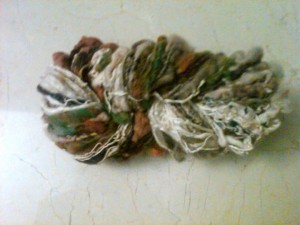 Well, we are back this week with another debate on a controversial topic. As I’m writing this, I’m smiling because I hear Suzy’s voice in my head saying, “We’re just making yarn, people!” She often says this in response to situations where fiber folk are taking things way too seriously. Despite her words of warning, this post might venture into that territory. This week, we’re taking a look at tension setting, the simple act of setting a hand spun yarn under tension after it’s been washed to force temporary balance to a yarn. I say “temporary” because as many of you know, once the yarn is wet again, the kinkiness will return which could be really unfortunate if the yarn has been used in a project where that quality is not valued!
Well, we are back this week with another debate on a controversial topic. As I’m writing this, I’m smiling because I hear Suzy’s voice in my head saying, “We’re just making yarn, people!” She often says this in response to situations where fiber folk are taking things way too seriously. Despite her words of warning, this post might venture into that territory. This week, we’re taking a look at tension setting, the simple act of setting a hand spun yarn under tension after it’s been washed to force temporary balance to a yarn. I say “temporary” because as many of you know, once the yarn is wet again, the kinkiness will return which could be really unfortunate if the yarn has been used in a project where that quality is not valued!
Somehow, one day, either Suzy or myself referenced the act of tension setting while I’m sure we were talking about something else that was probably much more important and before you know it, we were off debating the merits or pitfalls of this finishing technique. Since it’s my turn to blog this week, I thought I would post our discussion for your reading pleasure. Of course, we are curious as to your viewpoint as well and welcome your comments and thoughts on the post.
OK, ready? Here we go!!
Arlene: Ah, tension setting…a very controversial topic.
Suzy: Tension, just like stress, too much or too little and theres a problem. If you dont have enough things tend to get bunched up, overtwisted, too much and youre stretched out and falling apart!
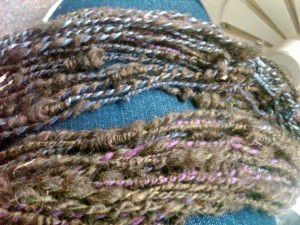 Arlene: First starters, a big confession from me. When I first started spinning, I tension set…A lot…I had read a well-known “art yarn” hand spinner’s book that advised tension setting. And, regardless of what type of yarn I was attempting to spin, I had mega twist (remember spinning didn’t come easily to me). But, once the yarn dried under tension, it looked like I had something going on. Honestly, I was encouraged to continue because of tension setting!
Arlene: First starters, a big confession from me. When I first started spinning, I tension set…A lot…I had read a well-known “art yarn” hand spinner’s book that advised tension setting. And, regardless of what type of yarn I was attempting to spin, I had mega twist (remember spinning didn’t come easily to me). But, once the yarn dried under tension, it looked like I had something going on. Honestly, I was encouraged to continue because of tension setting!
Suzy. Its certainly one way to deal with overtwisted yarn, and if you’re planning on using the yarn yourself, it probably doesnt matter too much, because at least you know its going to skew your project as soon as its washed and all that extra energy returns.
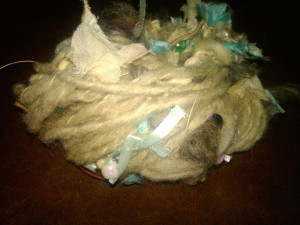 Arlene: Well, it certainly doesn’t matter if all you are ever going to do is look at your yarns! And, with a lot of those early yarns, that is what I did. Where I really got the sense a shame going around this procedure was when I went to the class of a very well known hand spinning teacher who teaches a lot of “art yarn” style techniques. In a very dramatic way she said, “If you are tension setting your yarns and then selling them, you are LYING.” I just wanted to crawl into a hole because I was thinking about selling my yarns and I could have easily committed the unspeakable crime she was carrying on about. But, there I was stuck with these overtwisted yarns, wanting so much to be able to spin balanced yarns, too new to be able to and on the verge of committing a heinous fiber crime! So, I stopped tension setting and slowly made my way to the land of balanced yarns
Arlene: Well, it certainly doesn’t matter if all you are ever going to do is look at your yarns! And, with a lot of those early yarns, that is what I did. Where I really got the sense a shame going around this procedure was when I went to the class of a very well known hand spinning teacher who teaches a lot of “art yarn” style techniques. In a very dramatic way she said, “If you are tension setting your yarns and then selling them, you are LYING.” I just wanted to crawl into a hole because I was thinking about selling my yarns and I could have easily committed the unspeakable crime she was carrying on about. But, there I was stuck with these overtwisted yarns, wanting so much to be able to spin balanced yarns, too new to be able to and on the verge of committing a heinous fiber crime! So, I stopped tension setting and slowly made my way to the land of balanced yarns
But, I am wondering, from your perspective, is there a place for tension set yarns?
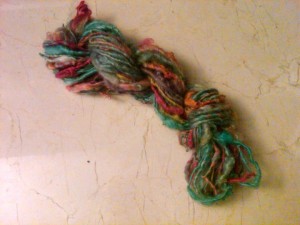 Suzy. I am sure there is. For a start, some things we make need a bit of character. Isn’t a scarf a whole bunch more interesting if it has a movement of its own? Who says it has to be flat and straight anyway? And there are also those items which we dont really wash a lot, hats, etc. In fact there are many things we can use over twisted yarns for that don’t require balanced yarn. Perhaps the more ‘traditional’ two ply yarns, that will be used for knitting to a pattern into fitted garments, they might not benefit from being unbalanced yarns, but there is now also a whole bunch of stuff out there ‘designed’ for what is known as ‘Energized yarns’ – yarns with extra twist (deliberately done) that can be used for creating amazing effects in both knitting and weaving. I am pretty sure over twisted art yarns can be put to many uses even without tension setting them.
Suzy. I am sure there is. For a start, some things we make need a bit of character. Isn’t a scarf a whole bunch more interesting if it has a movement of its own? Who says it has to be flat and straight anyway? And there are also those items which we dont really wash a lot, hats, etc. In fact there are many things we can use over twisted yarns for that don’t require balanced yarn. Perhaps the more ‘traditional’ two ply yarns, that will be used for knitting to a pattern into fitted garments, they might not benefit from being unbalanced yarns, but there is now also a whole bunch of stuff out there ‘designed’ for what is known as ‘Energized yarns’ – yarns with extra twist (deliberately done) that can be used for creating amazing effects in both knitting and weaving. I am pretty sure over twisted art yarns can be put to many uses even without tension setting them.
Arlene: However…I sense that you don’t go about making them with purpose. I don’t. I don’t want to contend with it. I will run the yarn through the wheel and get some of that twist out. While I admire people who can use over twist to their advantage and I think the yarns look great, even after taking classes on it from the best folks around, when left to my own devices, I don’t make those types of yarns. It just doesn’t resonate with me, I guess. And, I’m afraid I can’t go back to the Land of Overtwist and tension setting it out.
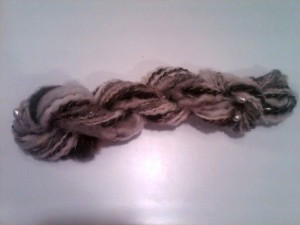 Suzy: Perhaps the main thing is to see every skein we make as an opportunity to learn something. We all make/have made skeins that we don’t like, and often that will be because it is just plain overspun.. too much twist makes hard, wirey, and twisty yarn, properties that no amount of tension setting is really going to get rid of completely. I would hate to think that someone might give up, or get disheartened, because of a bit of over twisting, especially in the early days of spinning. Its probably THE most common problem for new hand spinners. Suggesting to a new hand spinner that the method they are using to make their early yarns more useable and easier on the eye by tension setting is ‘lying’ or in some way dishonest, puts a very negative focus on it and may well put people off hand spinning all together. Perhaps if the yarn is going to be sold, that might be when its better not to tension set, so the end user can see how the yarn is going to sit when its knitted and washed up, but selling yarn is very different from making yarn for your own use, or to share with friends, and I daresay most new hand spinners are not going to put their yarns on the market until they feel confident in their quality.
Suzy: Perhaps the main thing is to see every skein we make as an opportunity to learn something. We all make/have made skeins that we don’t like, and often that will be because it is just plain overspun.. too much twist makes hard, wirey, and twisty yarn, properties that no amount of tension setting is really going to get rid of completely. I would hate to think that someone might give up, or get disheartened, because of a bit of over twisting, especially in the early days of spinning. Its probably THE most common problem for new hand spinners. Suggesting to a new hand spinner that the method they are using to make their early yarns more useable and easier on the eye by tension setting is ‘lying’ or in some way dishonest, puts a very negative focus on it and may well put people off hand spinning all together. Perhaps if the yarn is going to be sold, that might be when its better not to tension set, so the end user can see how the yarn is going to sit when its knitted and washed up, but selling yarn is very different from making yarn for your own use, or to share with friends, and I daresay most new hand spinners are not going to put their yarns on the market until they feel confident in their quality.
 Arlene: I think you’ve really summed things up really wonderfully! So, we agree!! Tension setting is not all evil, afterall…and to the teacher who told me it was lying, if you are reading this, please remember how impressionable beginners can be…:-)
Arlene: I think you’ve really summed things up really wonderfully! So, we agree!! Tension setting is not all evil, afterall…and to the teacher who told me it was lying, if you are reading this, please remember how impressionable beginners can be…:-)
So, there you go. What do you think about all of this? Are you like me and did it in the beginning and then let it go or do you still do it sometimes? Or are you a beginner and you find it encouraging and helpful to be able to tension set?
P.S. All the pictures of the yarns in this post are my “beginner” yarns and were all tension set, of course!
Sometimes now……………I did in the begining, like we all read about in the fiber books.
What a wonderful post, especially for beginners, very encouraging.
I’ve overspun a lot in my days and now I have to say that I love the balanced yarn, it seems to show off much better its qualities and softness.
What a great balanced post on this topic (balanced… get it!). Its not lying that those over-twisted yarns might not be lying flat! (enough puns already). I once knit a sweater from a commercial yarn that was overtwisted, and it ended up in the trash after one wearing because it twisted and bound something crazy, so I’ve very conscious of what overtwisted yarns are capable of. I’m in the ‘don’t block your yarns’ camp, especially if you’re selling, so people can really see what they are getting. There are ways to compensate — for example, garter stitch, knit flat, usually does a good job of balancing out overspun yarn.
I think fleece type needs to be considered too. I also like spinning with uncarded semi-washed fleece from time to time. I wash and set these. Always – they smell funky if I don’t. I don’t put a lot of tension on. Most of my yarns get left on the skein winder overnight – I concider this a way of setting tension. So I’m pretty much on the fence with tension setting. However – I think that a bit of overspun here and there is like leaving a fingerprint. It says made by hand and it gives life to the final product. However – it should never be to such an extent that it ruins the final product, and it shouldn’t be hidden from the buyer. I’m teaching a spinning class using mostly drop spindles soon. To analyse errors and how to correct them I am busy spinning up a ‘beginners yarn’ It is lumpy, overspun, underspun… And I can’t let yarn go to waste, so I started knitting with it – straight off the spindle. I knew the yarn was (very!) imperfect, and because I knew, I love the resultant texture. There’s a place for everything I guess. Now if I tensioned this particular yarn and sold it… I deserve having the hounds of hades set upon me!!!
I always set the twist by soaking the yarn, but I only tension singles that have way to much overspin.
I LOVE a hat that is made from overtwisted yarns because they don’t loose their “shape” and have to be reshaped very often. It gives them a bit of “stretch” in the hat, stocking cap type hats for winter of course are the kind I am referring to.
I also love to make shawls that are going to be felted down after weaving from a slightly overtwisted yarn. Once it is felted it lays flat but it appears to me that the overtwisted yarns felt up better, maybe because they are pulling closer before the felting process??
These are just my observations and not any gospel or anything.
I use both methods depending on what the final yarn will be used for. I like the effect of overtwist in some finished objects. I don’t completely agree with the “lying” bit because I have made singles, tension finished them and worked up a finished piece which was washed and the over twist doesn’t return. It’s all in the degree of overtwist and learning how to handle it (embrace it, tension finish, run it through to unply, etc)
I believe like most artistic things, we craft by hand so we have control and freedom to create our personal fiber, which means as long as we the artists are getting what we want , it’s all good!
i use to set….but stopped over a year ago…..and i really enjoy the process of getting an balance yarn / or not balanced……i feel that it has been a great study of my spinning
I am smiling from east to west while reading this, you both are made for each other!! Laurel and Hardy, in a good way! I am looking at my over twist yarn without feeling embarrassed! great topic for the me as I am self taught . Thank you Arlene and Suzy!
I like yo try to spin my yarns as balanced as I can. But on occasion I do get over twist. I usually know I am getting it while spinning. One way I try to balance it is by leaving it on the spool a few days. Believe or not it helps if the over twist is not to bad. Then I’ll leave it on the niddy noddy over night. If it’s a wonderfully clean fleece and smells nice I won’t set it in water. If it still has a bit of an a smell to it (which I admit I don’t mind) I will wash and set it. I sell on etsy and have found my customers like a nicely smelling yarns hat hangs straight. Over twist for some projects as Suzy stated makes for a fun live yarn. But then again if selling it and it’s not expected it could look like a poorly spun yarn. So I think it depends on many factors. Such as what it was meant for. How you want your project to look when it’s completed. Who your customers are and how you’ve depicted the yarn in your description. My opinion. (:
Pingback: Featured Artist: Debbie Johnson of Hampton Artistic Yarns and More! — Spin Artiste - Handspun Yarn
I’m in camp “Don’t Tension!!”, most of the time. I’m also in camp “Serious Yarn Maker”, most of the time. (We aren’t “just making yarn people!” We’re making a usable lasting product from scratch!!!!! That’s that part of me that insists perfection, balance, function, and beauty does not have to be an either or situation) With my “serious” yarns I strive really hard for balance, and refuse to tension them. (I have a few tricks up my sleeve to achieve it)
However, with art yarns, achieving balance is really difficult (for me) and, generally they are pretty low yardage, and any twist can be let out before working with it. I will give those a tension finish, but they are generally for my personal use anyway. I don’t sell those ones. They just make the chaos part of me happy 🙂
Well, I admit it–I do tension set and have found it so wonderful to see the twisted up mess turn into a nice balanced skein. I had never thought of it as a “bad” thing. I don’t sell my yarn (yet anyway) but I hadn’t considered this might be dishonest or somehow not a good thing. I had also not considered that my twisted up over-energized art yarns could be used when they are so over-twisted. Recently I took my first Navajo ply attempt which was a twisted up mess, soaked it for an hour, whacked it, set it out to hang with a towel and when it dried it was a lovely balanced skein–so I’m still not sure why that’s “wrong” but it sure does make me feel good when I look at it. So is what you are saying that a more experienced spinner would just have left it twisted and found a use for it in that state? I would love to know your comments about this as I try to figure this out, thanks for the great topic!
A more experienced spinner may or may not have left it twisted…it “depends”…:-)
I really enjoyed this article, because this is a subject I’ve thought a lot about. This might not be a popular thing to say, but I feel like telling spinners that any type of singles yarn or unplied core-spun yarn can be balanced (without other treatments) is setting them up for disappointment. In my experience no matter how softly spun a singles yarn is, it will ply back on its self because that twist energy needs somewhere to go! I’ve read that certain teachers are able to accomplish balanced singles yarns, but I haven’t had the pleasure of studying with them.
I guess I should have noted that when I talk about balanced yarns I always mean ‘plied’ balanced yarns. I think something that disappoints many new spinners is thinking that they can achieve (or should) a balanced single, when by definition thats impossible, it can never be balanced because of the twist that is required to hold it together! If anyone says they can make a balanced single they are (IMO) misinformed about what ‘balanced’ actually is. I think balance refers to the balance that can be found between two singles in which the twist in each single balances out the other one, forming a yarn that does not try to twist on itself even after its been washed (re-wet) and the twist reactivated. Making a singles yarn that hangs ‘like’ a balanced yarn might be almost possible with a low enough twist, but it can never be perfectly balanced in the same way as a plied yarn because the twist will always be going in one direction.
Thanks for writing that Suzy! It makes me feel less like I’m crazy 😉 I was especially frustrated by the idea of a balanced core-spun yarn and even took a special class because a friend had promised it would help me in that regard. It was a fun class, and I made a yarn sample that became a cool necklace, but it was still very twisty!
Wow! This is indeed a great post. I understand the need for Tension Setting. But— it has weighed on me how anyone could be selling certain of these yarns— I mean, if it’s a yarn that any given individual alone is going to work with, that’s one thing entirely. And/or if the end product will require little laundering, if ever, i.e. a woven wall hanging— then No Harm, No Foul. And while I appreciated the ‘you’re lying’ analogy— [a brilliant way to drive it home] if a spinner spins for Production, it is a benefit to us All, that the customer should never have to question exactly what they are getting.
Love this post!! Blessings~
Thanks everyone. This conversation answered my question. I just finished spinning my first yarn for the creative fleece class. I really did not want to tension set because of the
metallic threads I used for plying. Plus the yarn seemed pretty balanced to me. So, now I have my answer.
I do find it is ok to the break the “rules” how do you ever learn if you do not try the” what ifs”.